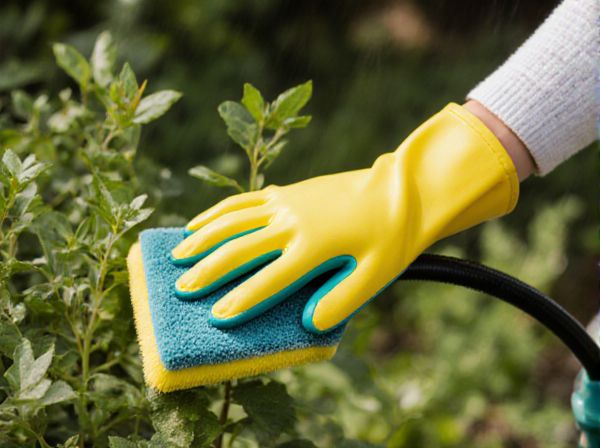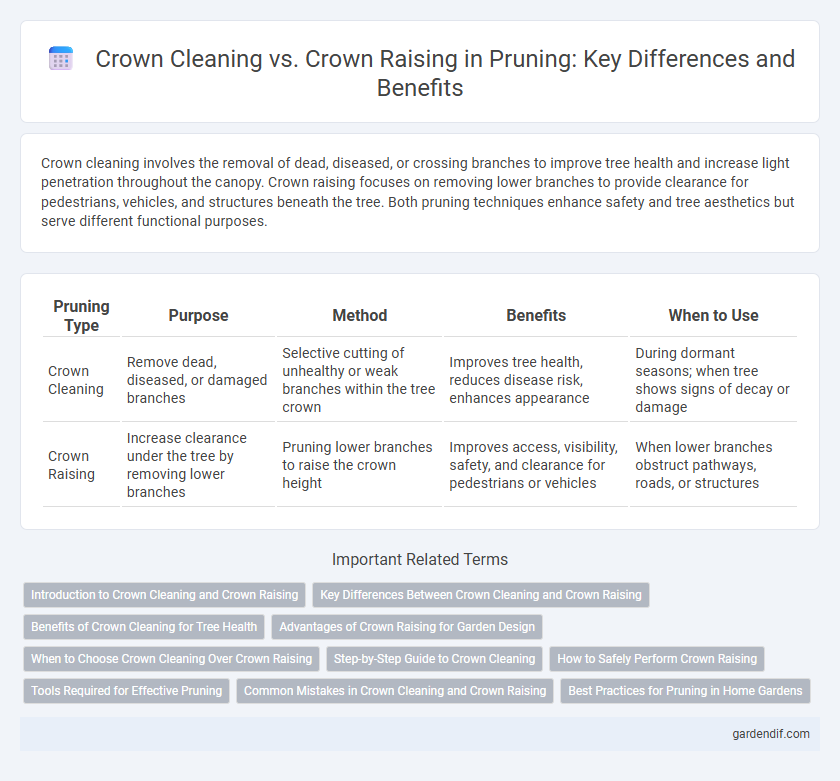
Crown cleaning vs crown raising Illustration
Crown cleaning involves the removal of dead, diseased, or crossing branches to improve tree health and increase light penetration throughout the canopy. Crown raising focuses on removing lower branches to provide clearance for pedestrians, vehicles, and structures beneath the tree. Both pruning techniques enhance safety and tree aesthetics but serve different functional purposes.
Table of Comparison
| Pruning Type | Purpose | Method | Benefits | When to Use |
|---|---|---|---|---|
| Crown Cleaning | Remove dead, diseased, or damaged branches | Selective cutting of unhealthy or weak branches within the tree crown | Improves tree health, reduces disease risk, enhances appearance | During dormant seasons; when tree shows signs of decay or damage |
| Crown Raising | Increase clearance under the tree by removing lower branches | Pruning lower branches to raise the crown height | Improves access, visibility, safety, and clearance for pedestrians or vehicles | When lower branches obstruct pathways, roads, or structures |
Introduction to Crown Cleaning and Crown Raising
Crown cleaning involves the removal of dead, dying, or diseased branches from a tree's canopy to improve health and enhance airflow. Crown raising focuses on lifting the lower branches to provide clearance for pedestrians, vehicles, or structures, typically by pruning branches to a specified height. Both techniques contribute to tree maintenance but target different aspects of crown management for optimal growth and safety.
Key Differences Between Crown Cleaning and Crown Raising
Crown cleaning involves the selective removal of dead, diseased, or crossing branches to improve tree health and enhance light penetration within the canopy, whereas crown raising removes lower branches to increase clearance beneath the tree for pedestrian or vehicle access. Crown cleaning primarily targets the interior structure of the crown, enhancing overall tree vitality, while crown raising modifies the tree's vertical profile for practical space management. Understanding these key differences is essential for optimizing tree maintenance strategies and ensuring safety and aesthetic value.
Benefits of Crown Cleaning for Tree Health
Crown cleaning enhances tree health by removing dead, diseased, or damaged branches, reducing the risk of pest infestations and decay. This practice improves air circulation and light penetration within the canopy, promoting photosynthesis and overall vitality. Regular crown cleaning also minimizes the potential for branch failure, ensuring structural stability and longevity of the tree.
Advantages of Crown Raising for Garden Design
Crown raising enhances garden design by increasing light penetration and air circulation beneath trees, promoting healthier lawn and understory plant growth. This pruning technique improves visibility and accessibility, creating open, inviting spaces ideal for outdoor activities and aesthetic appeal. Unlike crown cleaning, crown raising maintains canopy structure while shaping tree height to complement landscape layout and architectural features.
When to Choose Crown Cleaning Over Crown Raising
Choose crown cleaning over crown raising when the primary goal is to remove dead, diseased, or loose branches without altering the tree's natural shape or height. Crown cleaning enhances tree health by improving airflow and reducing pest risk, making it ideal for maintenance during dormant seasons or after storm damage. Opt for this method when maintaining the tree's aesthetic appearance is more important than increasing clearance or light penetration beneath the canopy.
Step-by-Step Guide to Crown Cleaning
Crown cleaning involves the careful removal of dead, diseased, or broken branches to improve tree health and sunlight penetration, unlike crown raising, which primarily focuses on lifting lower branches to increase clearance. Begin by assessing the tree's structure, identifying unhealthy or overlapping branches that hinder airflow. Use appropriate pruning tools to selectively cut these branches, ensuring clean cuts to promote healing and prevent disease spread.
How to Safely Perform Crown Raising
Crown raising involves selectively removing lower branches to increase clearance between the ground and the tree canopy, improving access and visibility while minimizing damage. To safely perform crown raising, use sharp pruning tools, make clean cuts at branch collars, and avoid removing more than 25% of the live crown to reduce stress on the tree. Proper safety equipment, including gloves, eye protection, and stable ladders, helps prevent accidents during the pruning process.
Tools Required for Effective Pruning
Effective crown cleaning requires tools such as pruning shears, loppers, and hand saws to remove dead, diseased, or crossing branches, promoting tree health and air circulation. Crown raising involves elevating the lower branches, needing pole pruners, pruning saws, and occasionally chainsaws to safely trim branches hinderances for pedestrian or vehicular clearance. Proper use of sharp, sanitized tools ensures clean cuts that minimize tree stress and reduce the risk of infection during both crown cleaning and crown raising.
Common Mistakes in Crown Cleaning and Crown Raising
Common mistakes in crown cleaning include excessive removal of live branches, which weakens tree structure and increases susceptibility to pests and diseases. In crown raising, a frequent error is cutting too close to the branch collar, leading to poor wound healing and potential dieback. Both practices suffer from improper timing and over-pruning, resulting in stress, reduced photosynthesis, and diminished tree health.
Best Practices for Pruning in Home Gardens
Crown cleaning involves the removal of dead, diseased, or damaged branches to promote tree health and improve air circulation, while crown raising focuses on removing lower branches to increase clearance for pedestrians and structures. Best practices for pruning in home gardens include using sharp, clean tools to make precise cuts, avoiding excessive removal to prevent stress on the tree, and timing pruning activities during dormancy or late winter to minimize sap loss and pest infestation. Proper identification of tree species and understanding their specific growth patterns ensures effective crown cleaning and raising without compromising the tree's structural integrity or aesthetics.
Crown cleaning vs crown raising Infographic

 gardendif.com
gardendif.com